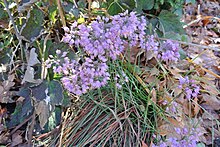Allium thunbergii
| Allium thunbergii | |
|---|---|

| |
| Allium thunbergii 'Ozawa' in the garden of botanist Robert R. Kowal, Madison, Wisconsin | |
| Scientific classification | |
| Kingdom: | Plantae |
| Clade: | Tracheophytes |
| Clade: | Angiosperms |
| Clade: | Monocots |
| Order: | Asparagales |
| Family: | Amaryllidaceae |
| Subfamily: | Allioideae |
| Genus: | Allium |
| Species: | A. thunbergii
|
| Binomial name | |
| Allium thunbergii | |
| Synonyms[1] | |
|
Synonymy
| |

Allium thunbergii, Thunberg's chive[2] or Thunberg garlic,[3] is an East Asian species of wild onion native to Japan (incl Bonin + Ryukyu Islands), Korea, and China (incl. Taiwan).[4] It grows at elevations up to 3000 m. The Flora of China recognizes A. tunbergii and A. stenodon as separate species, but more recent sources combine the two.[1][5][6][7][8][9]
Allium thunbergii produces one or two egg-shaped bulbs up to 20 mm in diameter. Scapes are up to 50 cm tall. Leaves are longer than the scape, hollow, triangular in cross-section. Umbels are crowded with many red or purple flowers.[5][6][10][11][12][13][14]
The specific epithet thunbergii references the Swedish botanist Carl Peter Thunberg.[15]
This plant has gained the Royal Horticultural Society’s Award of Garden Merit.[3]
- Varieties[4]
- Allium thunbergii var. deltoides (S.O.Yu, S.Lee & W.T.Lee) H.J.Choi & B.U.Oh - Gayasan National Park in Korea
- Allium thunbergii var. teretifolium H.J.Choi & B.U.Oh - Korea
- Allium thunbergii var. thunbergii - China, Japan, Korea
References
- ^ a b The Plant List
- ^ Korea National Arboretum (2015). English Names for Korean Native Plants (PDF). Pocheon: National Arboretum. p. 348. ISBN 978-89-97450-98-5. Archived from the original (PDF) on 25 May 2017. Retrieved 27 November 2016 – via Korea Forest Service.
- ^ a b "Allium thunbergii". Royal Horticultural Society. 2002. Retrieved 5 January 2018.
- ^ a b Kew World Checklist of Selected Plant Families
- ^ a b Flora of China v 24 p 197, Allium thunbergii
- ^ a b Flora of China v 24 p 179, Allium stenodon
- ^ Ohwi, J. (1984). Flora of Japan (in English): 1-1067. Smithsonian Institution, Washington, D.C.
- ^ Kobayashi, S. & Ono, M. (1987). A Revised List of Vascular Plants Indigenous and Introduced to the Bonin (Ogasawara) and the Volcano (Kazan) Islands. Ogasawara Research 13: 1-55.
- ^ Choi & Oh 2011.
- ^ Don, George. 1827. Memoirs of the Wernerian Natural History Society 6: 84.
- ^ Nakai, Takenoshin & Kitagawa, Masao. 1934. Report of the First Scientific Expedition to Manchoukou 4(1): 18, pl. 6., as Allium stenodon
- ^ Liu, Tang Shui & Ying, Shao Shun. 1978. Flora of Taiwan 5: 45
- ^ P.P.Gritsenko. 1979. Byull. Vses. Ord. Lenina Inst. Rast. N.I. Vavilova 96: 23
- ^ line drawing of Allium thunbergii, Flora of China Illustrations vol. 24, fig. 221, 1-4
- ^ Harrison, Lorraine (2012). RHS Latin for Gardeners. United Kingdom: Mitchell Beazley. ISBN 978-1845337315.
Bibliography
- Choi, Hyeok JAE; Oh, Byoung UN (October 2011). "A partial revision of Allium (Amaryllidaceae) in Korea and north-eastern China". Botanical Journal of the Linnean Society. 167 (2): 153–211. doi:10.1111/j.1095-8339.2011.01166.x.
